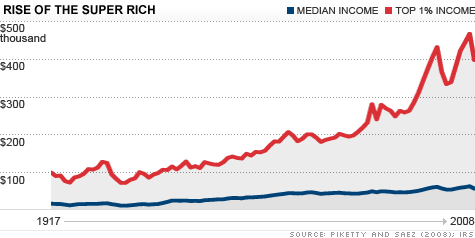As the leaders of the major economies gather for crisis
talks in at the G20 in Mexico ,
they’ll be pondering how they can save capitalism from itself. What they won’t
be doing is addressing the vast inequalities that have developed in countries
like the United States .
While president Barack Obama and his Republican opponent
Mitt Romney trade insults and accusations, neither will refer too often to the
real State of the Union . Here, for your
enlightenment, are some basic facts about a country usually described as the
world’s richest nation:
Poverty: The
US
poverty rate is estimated at 16.0% of the population. The Department of
Agriculture estimates that 14.5% of all households were "food
insecure" in 2010.
Unemployment:
US
unemployment is officially 8.2%. The employment-to-population ratio is nearly 5%
lower than just five years ago. Anywhere between 10 and 15 million Americans
are out of work.
Discouraged workers.
Discouraged workers are persons not currently looking for work because they
believe that there are no jobs available for them. The unemployment rate that
counts discouraged workers has soared to 15% of the workforce.
Income inequality: The
US
ranks third among all the advanced economies in the amount of income
inequality. The top 1% of Americans control nearly a quarter of all the
country's income, the highest share controlled by the top 1% since 1928.
Chief executive officers in 1965 made 24 times more than the
average production worker, whereas in 2009 they made 185 times more, falling from
a peak of 300 times in 2000.
The median value of family income, when adjusted for
inflation and before taxes, fell by 7.7% — from $49,600 in 2007 to $45,800 in
2010.
Racial gaps in education.
High-school drop-out rates are least among whites and highest among
Hispanics, while college enrolment rates are least among blacks and highest
among whites.
Child Poverty. In
the United States ,
21% of all children are in poverty, a poverty rate higher than what prevails in
virtually all other rich nations.
Health insurance.
In 2007, 8.1 million children under 18 years old were without health insurance.
Children in poverty and Hispanic children were more likely to be uninsured.
“Bad jobs”. About
10% of full-time workers are in low-wage jobs, 30% don't have health insurance,
and 40% don't have pensions.
Wealth inequality.
Ownership of wealth among households in the US has become more concentrated
since the 1980s. The top 10% of households controlled 68.2% of the total wealth
in 1983 and 73.1% of the total wealth in 2007.
Deregulation of the labour
market. The percentage all wage and salary workers who are union members
has declined from 24% in 1973 to 12.4% in 2008. At the same time, the real
value of the minimum wage, which fell by 25% in the 1980s, has not recovered.
Incarceration. The
incarceration rate in the United States
has grown dramatically since the 1970s and the US now has one of the highest rates
in the world. A full 37% of those who are both young black males and high
school dropouts are now in prison or jail, a rate that's more than three times
higher than in 1980.
In November, the half of America that votes in presidential
elections will be presented with a “choice” between Romney, whose net worth is
estimated at $200 million and would undoubtedly widen inequality, and Obama who
has appeased the rich and watched inequality grow since he took office in 2008.
For a system that claims it is based on competition and
choice, there is really none at all when it comes to the ballot box.
Paul Feldman
Communications editor


No comments:
Post a Comment